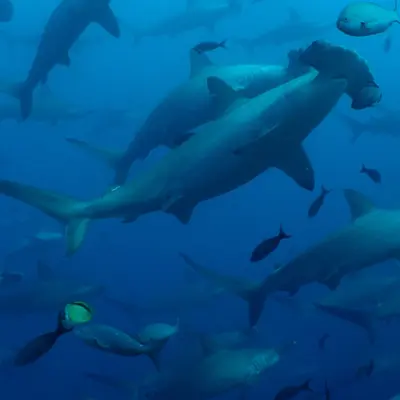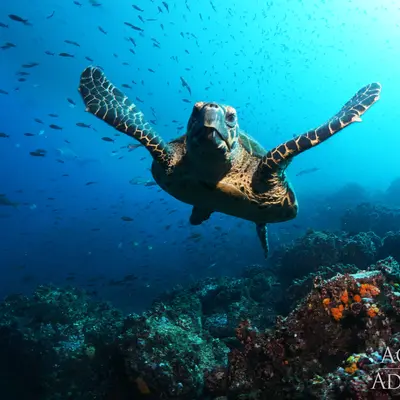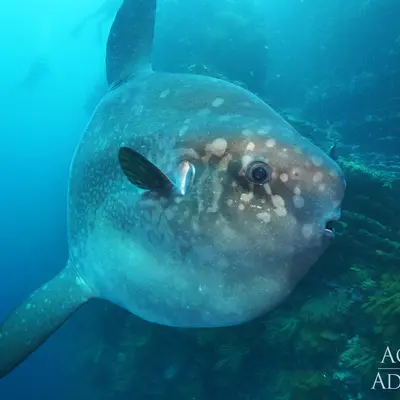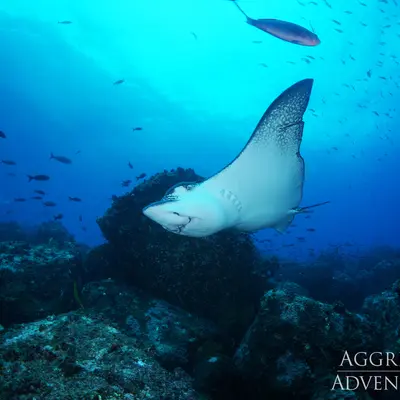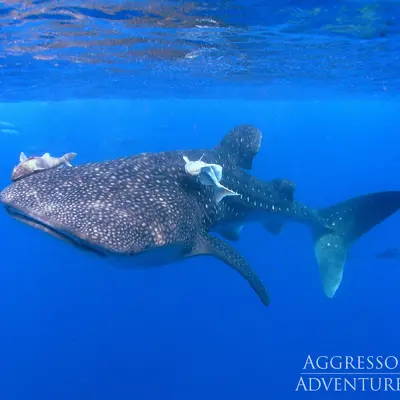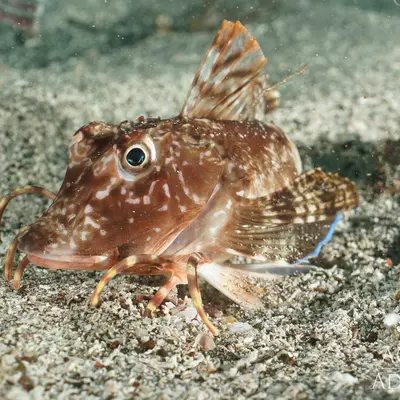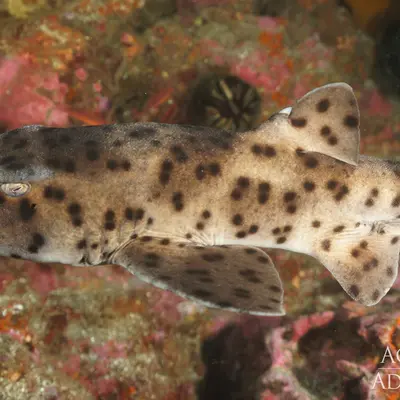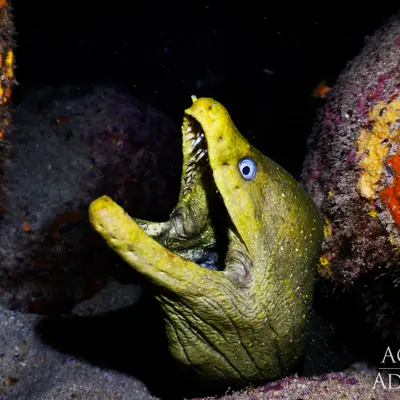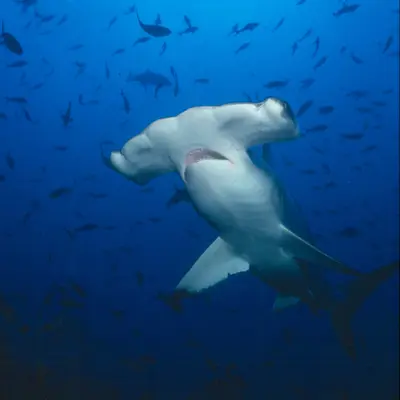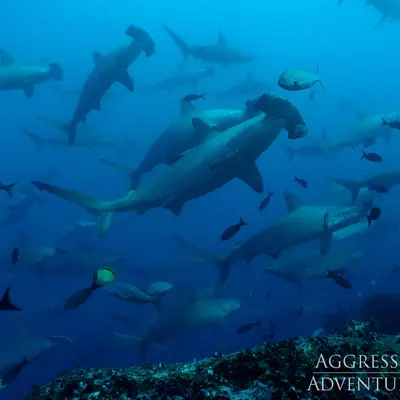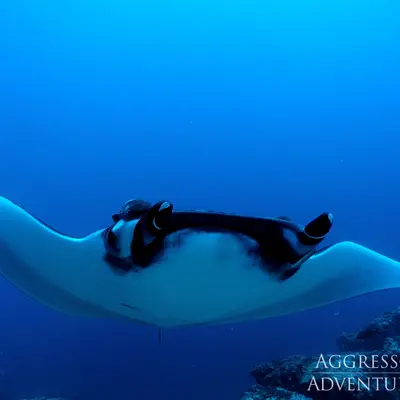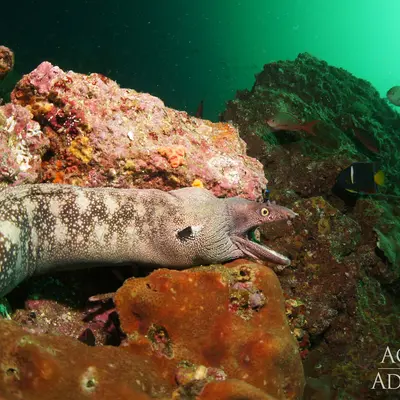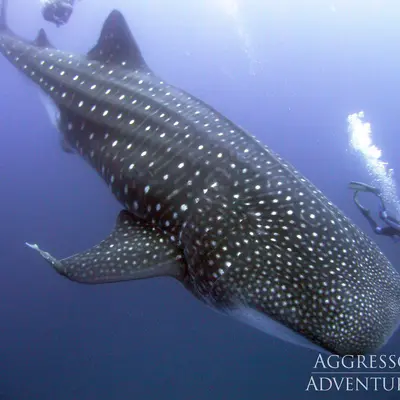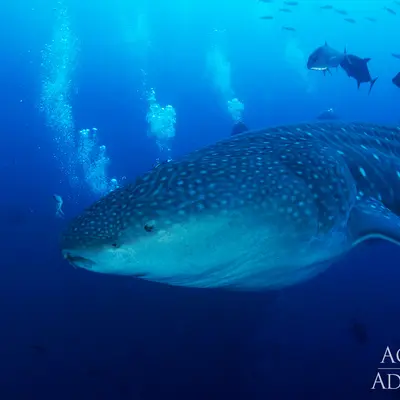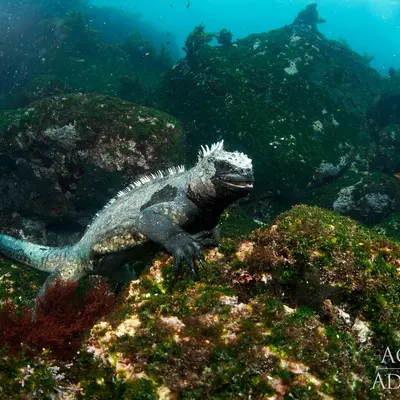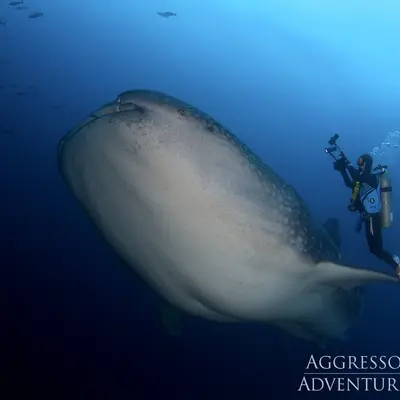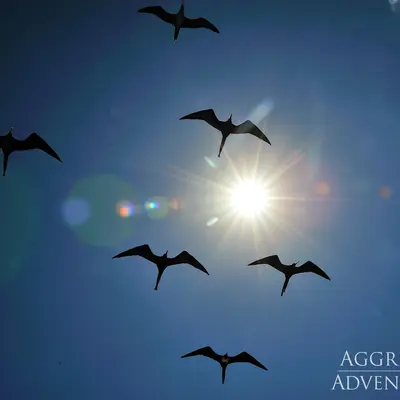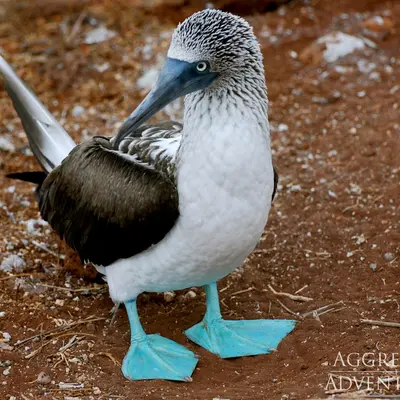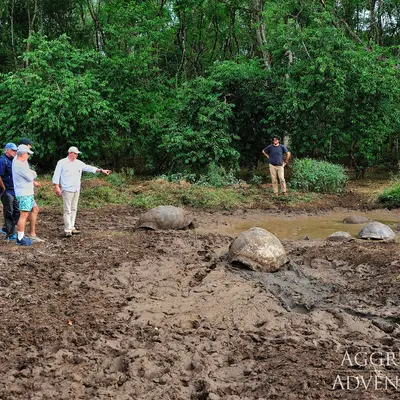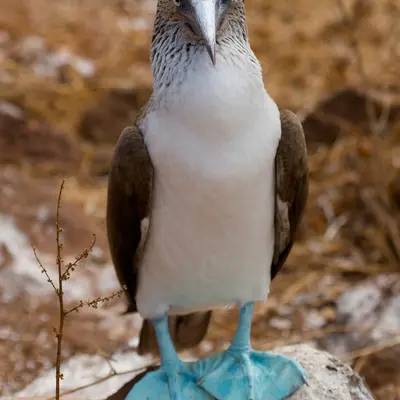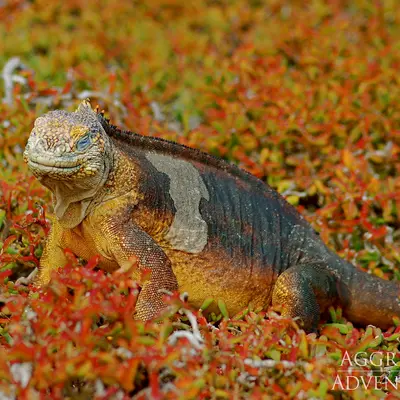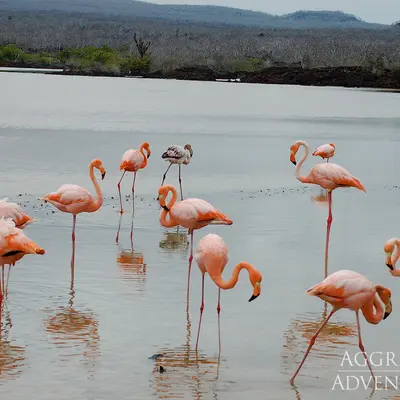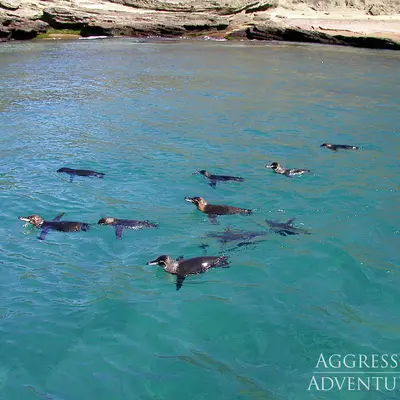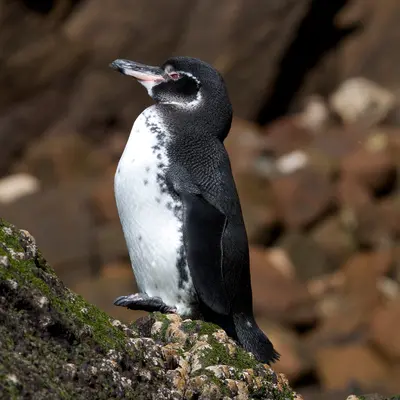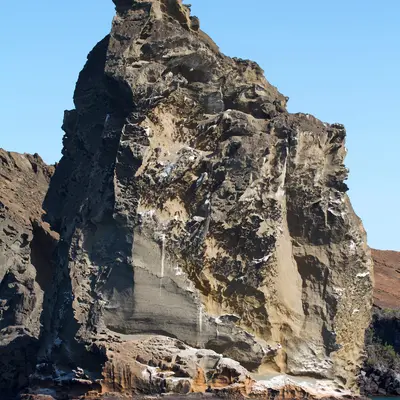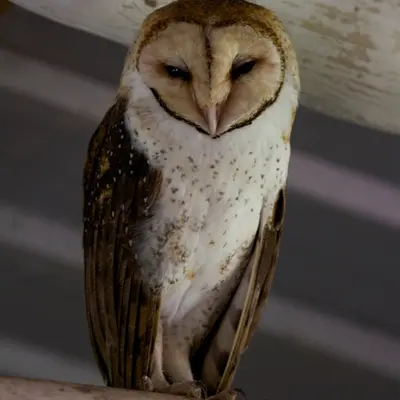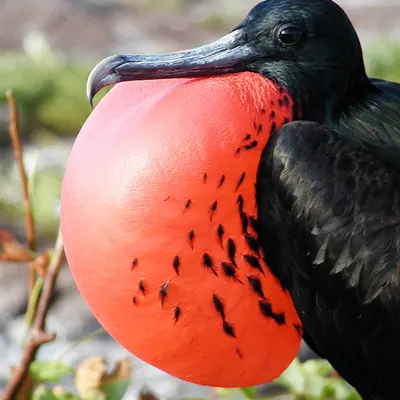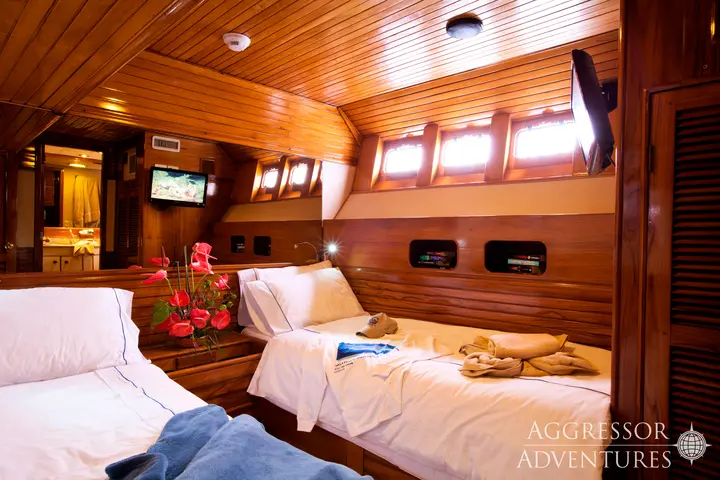The Galapagos Aggressor III is built for comfort, stability and safety to ensure a smooth journey around the Galapagos Islands. The 7-night itineraries depart from Baltra and visit Wolf, Darwin, Punta Carrion, Cabo Douglas, Punta Vicente Roca and Cousins Rock. Diving at Wolf and Darwin offers incredible encounters with hammerhead sharks, playful sea lions, turtles, whale sharks and even mola mola.
The spacious dive platform offers plenty of storage space and personal lockers, a swim platform, air/nitrox filling stations, rinse tanks, a three-stage camera table with low pressure air hoses and 2 hot freshwater showers. The inflatable boats make it easy to get to and from the dive sites.
This website uses Google Maps to embed map material. Please note that your personal data may be collected in the process. To view the Google Maps map, please agree that it is loaded from the Google server.
The Galapagos Aggressor III offers comfort and a high standard of service while exploring the world-famous dive sites of the Galapagos Islands. The Galapagos Aggressor III accommodates up to 16 guests in 9 cabins. Accommodation includes 4 deluxe cabins with twin beds on the lower deck and 4 master cabins with single or double beds on the upper deck. All cabins are equipped with en-suite bathrooms, individually controlled air conditioning, a TV monitor with media player and a hairdryer.
The master cabins offer sea views with large panoramic windows. Common areas on board the Galapagos Aggressor III include a spacious lounge and dining area serving a varied menu of American and local cuisine. Breakfast and lunch are served buffet style and dinner is prepared and served by the chef. On the upper deck there is a large, shaded solarium with a Jacuzzi, deckchairs, armchairs, a bar and a barbecue.
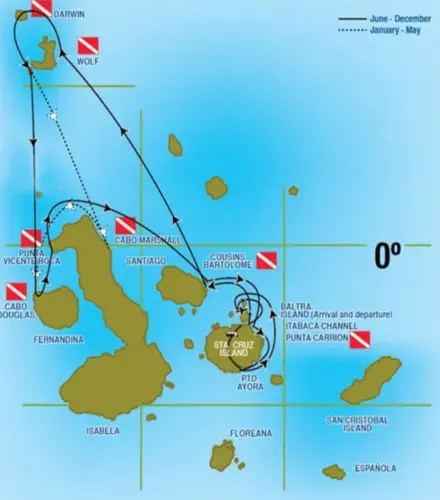
Galapagos is one of the most exciting destinations in the world.
The scenic view of Darwin Arch is as picturesque as you can imagine.
The following dive plan is based on tides, currents and weather conditions.
Day 1, Thursday: Arrival at Baltra Airport in the afternoon, followed by a warm welcome from our staff. You will then take a bus transfer to the Itabaca Channel, where you will board the boat. A welcome and orientation dive awaits you in Punta Carrion on the Itabaca Channel.
Day 2, Friday: Two morning dives are planned either in Punta Carrion (Santa Cruz Island) or in Bartolome Punta. In the afternoon, you can go on a hike to Bartolome Summit and a panga ride at Pinnacle Rock.
Day 3, Saturday:
From January to May, two morning dives are planned in Darwin, followed by two afternoon dives in Wolf.
From June to December, guests can enjoy two morning dives and two afternoon dives in Darwin.
Day 4, Sunday:
From January to May, guests can look forward to four dives at Wolf (two dives in the morning and two dives in the afternoon).
From June to December, there are two dives in the morning and one dive in the afternoon.
Day 5, Monday:
From January to May, four dives are planned at Cabo Marshall (two dives in the morning and one dive in the afternoon).
From June to December, guests enjoy two morning dives in Darwin and two afternoon dives in Wolf.
Day 6, Tuesday: Two morning dives are planned at Cabo Douglas, followed by two afternoon dives at Punta Vicente Roca.
Day 7, Wednesday: Guests start the day with a morning dive at Cousins Rock. In the afternoon, the boat reaches the Itabaca Channel or Puerto Ayora. After lunch, guests disembark for a private bus tour to explore the picturesque highlands of Santa Cruz Island, including a visit to a turtle reserve to observe giant tortoises. Guests will also have the opportunity to explore the town, go shopping and visit the Fausto Llerena Turtle Breeding Centre at the Charles Darwin Research Station. Dinner will be enjoyed ashore at a local restaurant of your choice (this is the only meal not included in the cruise). The Galapagos Aggressor will depart from Puerto Ayora to Baltra at 10 pm.
Day 8, Thursday: Enjoy a hearty breakfast before checking out and departing to Baltra airport.
Galapagos Aggressor does not require a specific number of dives, but the destination is certainly not for beginners as the conditions can be a little harsh at times. It is recommended to do at least 50 dives in open water (no pool conditions).
Galapagos dive sites
- Santa Cruz Island, Punta Carrion
40ft - 90ft dive with white tip sharks, stingrays, eagle rays and marble rays, scorpion fish, sea turtles and sea lions. - Bartolome Punta
20ft - 90ft dive with groupers, creole fish, whitetip sharks, barracudas, scorpion fish, sea turtles, sea puffer fish, red-lipped batfish, reef corals and the occasional hammerhead shark and bottlenose dolphin. - Wolf Island
1 to 3 knots current; 40ft - 90ft dive with schools of hammerhead sharks, marble rays, Galapagos sharks, silky sharks, eagle rays, green turtles, octopus, sea lions, schools of bonito tuna, yellowfin tuna, snappers, groupers, wahoos, barracudas, almaco jacks, moray eels, parrotfish, dolphins, Galapagos reef corals, sea lions and fur seals. Occasional whale sharks and orcas. - Darwin Island
1 to 3 knots current; 40ft - 90ft dive with schools of hammerhead sharks, Galapagos sharks, silky sharks, eagle rays, green turtles, almaco jacks, snappers, groupers, wahoos, hawksbill turtles and whale sharks. Occasional manta rays and orcas. - Cabo Douglas, Fernandina Island
20ft - 90ft dive with Galapagos penguins, marine iguanas, flightless cormorants, sea lions, seahorses, sea turtles, horn sharks, red-lipped batfish, groupers, snappers and Creole fish. - Punta Vicente Roca, Isabela Island
20ft - 90ft dive with Galapagos horn sharks, red-lipped batfish, stingrays, marble rays, mola mola or Pacific ocean fish, seahorses, Galapagos penguins, flightless cormorants, shrimps, large schools of salema, king angelfish, slipper lobsters, blue-footed boobies, frigate birds and brown pelicans. - Cousin Rocks
20ft - 100ft dive with eagle rays, mackerels, sea lions, green turtles, barracudas, fur seals, king angelfish, snappers, puffer fish, groupers, marble rays, stingrays, creole fish, black corals. - Cabo Marshall, Isabela Island (itinerary from January to May)
20ft - 100ft dive with giant manta rays, creole fish, barracudas, white tip reef sharks, sea lions, fur sea lions, yellow fin tuna, groupers, snappers, salemas.
(*) The description of the itinerary is provided by the boat operator.
Marine life: Galapagos is one of the most exciting destinations in the world. Guests have the opportunity to dive with playful sea lions and travel to the famous Darwin and Wolf for thrilling dives to see hammerheads, whale sharks, tuna clouds and much more.
Sample itineraries and maps are for illustrative purposes only. The exact route and sites visited may change depending on local regulations, guest experience, weather and logistics and are at the captain's discretion.
Explore the Galápagos Islands on foot!
offers a variety of land excursions where visitors can experience an impressive variety of endemic animal species in their natural environment. The animals on the Galápagos Islands are often not very shy and can be observed at close quarters.
Recommended excursion destinations and animal observations:
-
Santa Cruz:
- Tortuga Bay: Known for its sandy beach, which is around two and a half kilometres long, this place offers the opportunity to observe marine iguanas in the crystal-clear water.
-
Isabela:
- Sierra Negra Volcano: A hike to the crater rim of the second largest volcano in the world offers impressive views of the surrounding landscape.
- Sierra Negra Volcano: A hike to the crater rim of the second largest volcano in the world offers impressive views of the surrounding landscape.
-
Española:
- Blue-footed booby spotting: these birds breed on the paths and are known for their striking blue feet.
- Blue-footed booby spotting: these birds breed on the paths and are known for their striking blue feet.
-
North Seymour:
- Frigatebirds: Both the Great and Magnificent species can be seen here during the breeding season when the males inflate their red throat sacs to attract females.
- Frigatebirds: Both the Great and Magnificent species can be seen here during the breeding season when the males inflate their red throat sacs to attract females.
-
South Plaza:
- Land iguanas: This lizard species is particularly numerous on this island and shows different shapes and colours depending on the island.
-
- Red cliff crabs and lava lizards: These animals are typical of the island and can be observed during the excursions
- Red cliff crabs and lava lizards: These animals are typical of the island and can be observed during the excursions
-
Santiago (James Bay):
- Galápagos fur seal: These shy animals can be spotted in the caves of the bay.
Note: Due to the protected status of the islands, it is forbidden to touch the animals. Nevertheless, most of the animals are unusually trusting and can be observed at close range.
During shore excursions (sometimes at extra cost) on the Galápagos Islands, visitors can experience an impressive variety of endemic animal species in their natural environment. The animals are often not very shy and can be observed at close range.
Double cabin lower deck
- 2 single beds
- Adjustable air conditioning
- En-suite bathroom
- max. 2 guests
Master cabin upper deck
- 1 double or 2 single beds
- adjustable air conditioning
- En-suite bathroom
- max. 2 guests
Included:
VAT, airport transfers, alcoholic drinks, soft drinks, tea & coffee, drinking water, wine with dinner, snacks, full board (all meals), dive packages, cabin towels, complimentary toiletries.
Required extras:
National park fees (100-200 USD per trip), visa and fees (20 USD per trip).
Optional extras:
travel insurance, diving insurance, tips, regional flights, rental equipment, Nitrox course, diving courses, additional dives, snorkelling set, WLAN (25 USD per item).
Prices for rental equipment
Rental equipment is available on this ship. Please indicate what you need on the booking form. Details below of what is included and the additional prices.
- 15 litre bottles 75-120 USD
- Regulators 60-90 USD per trip
- BCD 60-90 USD per trip
- Fin 50-75 USD per trip
- Mask 50-75 USD per trip
- Nitrox bottle100-150 USD per trip
- Snorkelling kit 50-75 USD per trip
- Torch 8 USD per day
- Dive computer 60-90 USD per trip
- U/W camera rental 100 USD
- Full equipment (with: Regulator, BCD, fins, mask, snorkelling set, torch, dive computer) 175-260 USD per trip
- Wetsuit 50-70 USD per trip
- Air temperature: Temperatures vary throughout the year between around 21.8 °C in September and 26.3 °C in March.
- Water temperature: The water temperatures range between 21.1 °C in September and 26.4 °C in March, providing ideal conditions for diving activities.
- Rainfall: The rainiest months are February and April, while September is the driest month.
The Galápagos Islands are an archipelago of volcanic origin in the eastern Pacific and belong to Ecuador. They are located about 1,000 kilometres west of the South American mainland. The archipelago consists of 13 main islands, several smaller islands and numerous rocks and reefs.
Climate
The climate of the Galápagos Islands is influenced by the cold Humboldt Current, which ensures relatively mild temperatures. There are two seasons:
- Warm, humid season (December to May) with temperatures between 24-30 °C and occasional tropical rainfall.
- Cool, dry season (June to November) with temperatures between 18-26 °C, often cloudy skies and stronger ocean currents.
Inhabitants & living conditions
Around 30,000 people live on the Galápagos Islands, mainly on the inhabited islands of Santa Cruz, San Cristóbal, Isabela and Floreana. Living conditions are basic due to the isolated location and many goods have to be imported from the mainland. Environmental protection plays a major role, as the islands are a UNESCO World Heritage Site and are strictly regulated.
Economy & livelihood
The main economic sectors are:
- Tourism: Sustainable ecotourism is the main source of income, as the islands are known for their unique wildlife.
- Fishing: Catching lobster and tuna is particularly important.
- Agriculture: Only possible on a small scale due to the limited area and climate (e.g. fruit and vegetable cultivation).
Religion
The majority of the population is Christian, predominantly Roman Catholic, as the islands belong to Ecuador, where Catholicism is widespread.
Significance in the Pacific
The Galápagos Islands are not only one of the most biodiverse ecosystems in the world, but also an important hotspot for biological research. Charles Darwin visited the islands in 1835 and developed his theory of evolution here. Today, they are a global symbol of nature conservation and sustainable tourism.
The combination of unique nature, strict environmental protection and their strategic location in the Pacific makes the Galápagos Islands one of the most fascinating travel destinations in the world.



